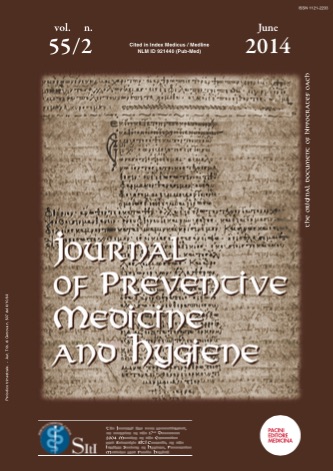Abstract
Objective. Precise identification of various morphotypes of Pseduomonas aeruginosa which developed during cystic fibrosis (CF) is of prime importance. We aimed to identify the isolates of P. aeruginosa recovered from CF patients at the genus and species level through primers targeting oprI and oprL genes via PCR. Methods. Sputum samples or throat swabs were taken from 100 CF patients and plated on cetrimide agar. All suspected colonies were primarily screened for P. aeruginosa by a combination of phenotypic tests. Molecular identification of colonies was per- formed using specific primers for oprI and oprL genes.Results. Based on phenotypic tests, P. aeruginosa isolates were recovered from 40% of CF patients. Forty isolates yielded ampli- con of oprI gene using genus-specific primers confirming the identity of fluorescent pseudomonads. However, 37 of 40 isolates yielded amplicon of oprL gene using species-specific primers, verifying the identity of P. aeruginosa. Conclusion. This study showed that the species-specific PCR tar- geting oprL gene can be used as accurate test for identification of highly adaptable P. aeruginosa in CF patients. This procedure may provide a simple and reliable method for identification of various morphotypes.References
Rowe SM, Miller S, Sorscher EJ. Cystic fibrosis. N Engl J Med. 2005;352:1992–2001.
Ratjen F, McColley SA. Update in cystic fibrosis 2011. Am J Respir Crit Care Med. 2012;185:933–936.
Pier GB, Grout M, Zaidi TS. Cystic fibrosis transmembrane conductance regulator is an epithelial cell receptor for clearance of Pseudomonas aeruginosa from the lung. PNAS. 1997;94:12088–12093.
Hart CA, Winstanley C. Persistent and aggressive bacteria in the lungs of cystic fibrosis children. Br Med Bull. 2002;61:81–96.
Starner TD, McCray PB. Pathogenesis of early lung disease in cystic fibrosis: a window of opportunity to eradicate bacteria. Ann Intern Med. 2005;143:816–822.
Hassett DJ, Sutton MD, Schurr MJ, Herr AB, et al. Pseudomonas aeruginosa hypoxic or anaerobic biofilm infections within cystic fibrosis airways. Trends Microbiol. 2009;17:130–138.
Mathee K, Ciofu O, Sternberg C, et al. Mucoid conversion of Pseudomonas aeruginos by hydrogen peroxide: a mechanism for virulence activation in the cystic fibrosis lung. Microbiology. 1999;145:1349–1357.
Worlitzsch D, Tarran R, Ulrich M, et al. Effects of reduced mucus oxygen concentration in airway Pseudomonas infections of cystic fibrosis patients. J Clin Invest. 2002;109:317–325.
Oliver A, Cantón R, Campo P, et al. High frequency of hypermutable Pseudomonas aeruginosa in cystic fibrosis lung infection. Science. 2000;288:1251–1253.
Ciofu O, Mandsberg LF, Bjarnsholt T, et al. Genetic adaptation of Pseudomonas aeruginosa during chronic lung infection of patients with cystic fibrosis: strong and weak mutators with heterogeneous genetic backgrounds emerge in mucA and/or lasR mutants. Microbiology. 2010;156:1108–1119.
Emerson J, Rosenfeld M, McNamara S, et al. Pseudomonas aeruginosa and other predictors of mortality and morbidity in young children with cystic fibrosis. Pediatr Pulmonol. 2002;34:91–100.
Sambrook J, Fritsch EF, Maniatis T. Molecular cloning. 2nd ed. New York: Cold Spring Harbor Laboratory Press; 1989.
Vos D, Lim A, Pirnay JP, et al. Direct detection and identification of Pseudomonas aeruginosa in clinical samples such as skin biopsy specimens and expectorations by multiplex PCR based on two outer membrane lipoprotein genes, oprI and oprL. J Clin Microbiol. 1997;35:1295–1299.
Miller MB, Gilligan PH. Laboratory aspects of management of chronic pulmonary infections in patients with cystic fibrosis. J Clin Microbiol. 2003;41:4009–4015.
Burns JL, Emerson J, Stapp JR, et al. Microbiology of sputum from patients at cystic fibrosis centers in the United States. Clin Infect Dis. 1998;27:158–163.
Kidd TJ, Ramsay KA, Hu H, et al. Low rates of Pseudomonas aeruginosa misidentification in isolates from cystic fibrosis patients. J Clin Microbiol. 2009;47:1503–1509.
Wessel AK, Liew J, Kwon T, et al. Role of Pseudomonas aeruginosa peptidoglycan-associated outer membrane proteins in vesicle formation. J Bacteriol. 2013;195:213–219.
Vos D, Bouton C, Sarniguet A, et al. Sequence diversity of the oprI gene, coding for major outer membrane lipoprotein I, among rRNA group I pseudomonads. J Bacteriol. 1998;180:6551–6556.
Vos D, Lim A, Jr., Vos P, et al. Detection of the outer membrane lipoprotein I and its gene in fluorescent and non fluorescent pseudomonads: implications for taxonomy and diagnosis. J Gen Microbiol. 1992;139:2215–2223.


